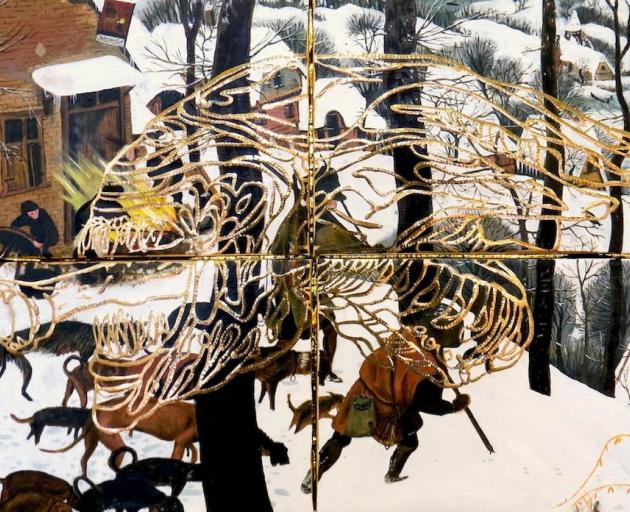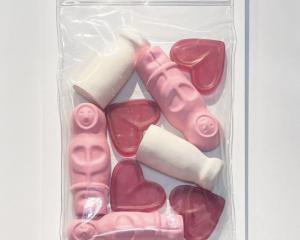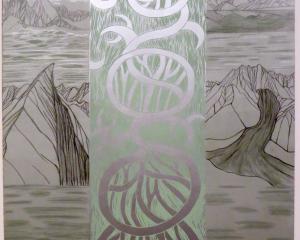In this week's Art Seen, James Dignan looks at exhibitions from Jenna Packer, Miranda Parkes, and a collaboration between Fu-On Chung and Sam Thomas.
 No Other Gods, by Jenna Packer
''Art of the Deal'', Jenna Packer (Milford Gallery)
No Other Gods, by Jenna Packer
''Art of the Deal'', Jenna Packer (Milford Gallery)

Jenna Packer's art continues to go from strength to strength, but has become darker and more sinister in her latest exhibition at the Milford Gallery.
In recent years, Packer's work has largely abandoned the attractive but largely dispassionate scenes of anachronistic air and sea craft plying the coast of some pioneer New Zealand, and have taken on a more overtly political edge.
Although hardly polemic, Packer's increasing concerns at the excesses of plutocracy and the ever-widening gap between the haves and have-nots have found their way into haunting dystopian scenes set in an Other-Zealand, the images mixing the watercolour-like blues and browns of early settler art with increasingly dark allegory.
The latest exhibition cranks the dystopia up one more step. As our society, to a jaundiced eye, may appear to be rushing headlong into a chasm, so too does that of Packer's alternative world. We see Wellington by way of Isengard, filled with dark satanic mills fuelled by human toil, all raised to worship the Bull God of commerce. Yet the images clearly indicate that beneath the public show of strength, these false idols are built on physically and metaphorically flimsy frames.
Equal parts Bosch, Nostradamus, and Industrial Revolution, these images are bleak and terrifying, but also astonishing and compelling in their conception.
 Rocket Science, by Miranda Parkes
''The Merrier'', Miranda Parkes (Hocken Collections Gallery)
Rocket Science, by Miranda Parkes
''The Merrier'', Miranda Parkes (Hocken Collections Gallery)

The Hocken is displaying an exhibition of work by 2016 Frances Hodgkins Fellow Miranda Parkes.
Parkes' colourful abstract work is predominantly painting-based, though also includes several other media. In her works, the artist seeks to erase the line between the art and the gallery space.
The paintings, papier-mache, fabric-work, and installation pieces are site-specific and extend beyond their expected boundaries, bursting out of their frames and creeping across the walls of the gallery towards each other. These are not discrete, flat images - they are straining to break free of their moulds.
The individual pieces are bright, vibrant abstracts, many of them toying with the regimented expectations of what an artwork should be. Framed pieces are painted on both front and back, paired works face reach other across cornices, and a printer's dirty drop-sheet becomes the canvas of a family collaboration.
It is probably better to consider the exhibition as a whole rather than as individual pieces. This is not a series of works, but rather an ecosystem.
More importantly, it is one that is both fun and welcomes the viewer into a warm, glowing gallery space. This gallery is no white box, but rather perceptually shifts with the metallic and pastel colours of its walls.
 Alien", by Sam Thomas.
''Swirling Dream-Wreck'', Fu-On Chung and Sam Thomas (Blue Oyster Gallery)
Alien", by Sam Thomas.
''Swirling Dream-Wreck'', Fu-On Chung and Sam Thomas (Blue Oyster Gallery)

As at the Hocken, the Blue Oyster's current exhibition blurs the lines between artwork and artspace. The display is a collaborative effort between Fu-On Chung and Sam Thomas, whose disparate styles sit oddly but effectively together.
Chung uses an abstract expressionist approach for his paintings, creating dark, rich canvases which have a sense of foreboding. Works such as the vibrant indigo and pink Fish Tanker create unease through their nature - abstract patterns which lie close to a dark edge of recognition.
Thomas' technique is more unusual. His mixed media works are oils painted on sheets of brass. Areas of unpainted metal have been hammered into textured bands, allowing for a brass image to appear superimposed over the painting.
The artist has used images from traditional European art and juxtaposed them with metallic designs - memorably so in a four-canvas work where an H. R. Giger alien appears to be menacing a Brueghel hunting party.
The gallery has been made a part of the work by the installation of a metal-threaded hypothermia blanket - a facet which complements Thomas' work more that Chung's.
The blanked turns the gallery into a cocoon, sheltering the viewer from the harsh and unwelcoming world outside, but also trapping him or her within its psychological space.







![Untitled (c. mid 1990s, [pink 3]), by Martin Thompson, 415mm×590mm. Photo: courtesy of Brett...](https://www.odt.co.nz/sites/default/files/styles/odt_landscape_small_related_stories/public/story/2024/02/untitled_pink_3.jpg?itok=Q0aQrc9o)




